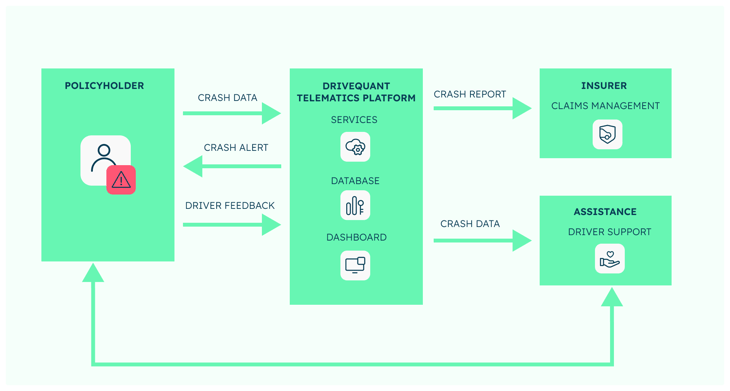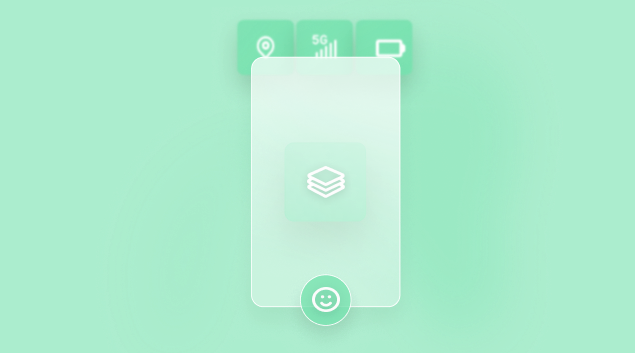Introduction
In addition to our driver behavior analysis and coaching services, DriveQuant mobile telematic solution also includes automatic crash detection.
This feature brings advantages to both the policyholder and the insurer:
-
The policyholder is contacted immediately after a detected crash and can be assisted depending on the context and severity of the event.
-
The insurer is informed of a coming claim within 20 seconds and can accelerate its management thanks to the contextual elements provided by our platform.
How does it work?
Automatic collision detection is composed of three cooperating elements:
1 - DriveKit, the DriveQuant SDK, collects trip data and records several key variables when an accident is detected.
2 - Signal processing and classification algorithms capable of analyzing the smartphone's sensors measurements to determine the crash probability.
3 - A comprehensive set of web services that alert the driver, help the courtesy call operator to make the right decision, and accelerate the processing by the claim adjuster.
What data do we use to detect crashes?
Our solution is universal and simple because it is based on smartphone sensor data. The collected data are relevant to detect and contextualize the conditions of a car accident.
Automatic crash detection is based on the following sensors:
-
The GPS sensor measures the car velocity, heading, and coordinates. These variables are sampled every second. This allows us to accurately analyze the vehicle's trajectory and extract the information needed to understand the context of a crash. Our platform provides the following information: the trajectory before the impact, the braking, the speed at the time of the collision, the deceleration following the impact, and even a change of trajectory indicating a swerve.
-
The accelerometer measures the accelerations applied to the smartphone along the three axes of its reference frame. The accelerations are sampled at 100 Hz and re-oriented in the earth's reference frame to measure the acceleration's intensity following an impact in a plane parallel to the road.
Most smartphones are equipped with an inertial unit that includes a gyrometer and a magnetometer in addition to the accelerometer. Data from these sensors are combined with the accelerations to measure the phone’s orientation and to calculate its orientation before, during, and after the crash.
To get an even more accurate picture of the circumstances of the crash, our SDK also saves other parameters such as the brightness of the screen, the activity detected by the phone, or the pressure variations in the vehicle. All this information helps to determine the context of the crash and answer critical questions such as: Was the driver using the phone before the collision? If so, was he making a call? Did the vehicle's airbag deploy?
This critical data for an insurer cannot be collected by traditional telematics devices, which is the main reason why we have opted for smartphone telematics.
How is a crash detected?
Our automatic crash detection solution is composed of three different stages.
SDK → CLASSIFIER
First, when our SDK detects that a trip has begun, it automatically triggers the trip recording. This is completely transparent to the driver because the application runs in the background.
As soon as a trip is being analyzed, the SDK continuously analyses the acceleration amplitude. Depending on the strength of the signal, it identifies a probable collision.
If a collision is detected (see graph below), our SDK sends the collision data to our data analysis platform for two reasons:
- The processing performed is more complex and requires more computing power;
- The data is stored for crash reporting purposes.

Data that indicates a collision.
The data analysis platform checks the quality of the data, applies processing to the signals and transforms the raw data into meaningful indicators to characterize the accident. We use more than 20 indicators derived from GPS speed and acceleration to discriminate between an accident and a false alarm.
These indicators are processed by a classifier that will determine the probability of an accident. The classifier is based on machine learning models trained on a database of labeled collisions that are either accidents or false positives.
CLASSIFIER → SUPERVISOR
The probability value of the classifier is then verified by a supervisor, which includes rules (which can be configured as needed) to confirm the accident. The rules are based on the probability value but also on additional parameters to reject false positives (measured collisions that are not actually accidents).
 An overview of the automatic crash detection system.
An overview of the automatic crash detection system.
What are the use cases in the event of a crash?
Automatic crash detection is an alert and decision support tool that reduces all the uncertainties derived from a crash and accelerates its claim management. This brings value to all.
On the policyholder side
If an accident is confirmed, the DriveKit SDK triggers a notification to the driver to check his or her health and ask for confirmation of the claim. The SDK sends the driver survey response to the courtesy call manager or indicates a no response. This information is added to the accident reports.
On the insurer side
Accident data is shared with all parties involved in the crash management.
-
Courtesy call or assistance operators accesses the crash data immediately after the event through a web interface. This helps to make the right decision: call in the emergency services or send a towing vehicle.
-
Claims adjusters can examine the crash data through the same interface and even access richer data through dedicated APIs. If a policyholder reports a claim in the following days or weeks, the claims handler can check whether the event reported by the policyholder matches a collision recorded by our platform.
Conclusion
Our automatic crash detection solution is universal because it is based on smartphone sensor data and effective because it further accelerates decision-making to help the policyholder and claims management. To deploy this functionality in your insurance company, contact us!



![[2025 Edition] The Guide to Connected Insurance](https://blog.drivequant.com/hubfs/7-%20%5BEdition%202025%5D%20Le%20Guide%20de%20lAssurance%20Connect%C3%A9e.png)
